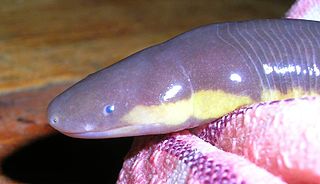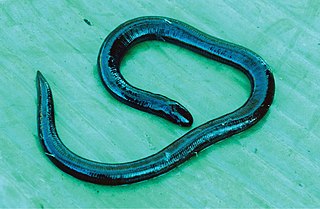
The Ichthyophiidae are the family of Asiatic tailed caecilians or fish caecilians found in South and Southeast Asia as well as southernmost China.

Ichthyophis orthoplicatus, also known as the Pattipola caecilian or brown caecilian, is a species of caecilian endemic to Sri Lanka. It is found in a range of natural and man-made habitats including evergreen forests, rubber and tea plantations, paddy fields, rural gardens and farms, wetlands, and cattle pastureland.

Ichthyophis pseudangularis is a species of caecilian endemic to Sri Lanka. It is found in a range of natural and man-made habitats: forests, rubber plantations, paddy fields, rural gardens and farms, wetlands, and pastureland.
Caecilia inca is a species of caecilian in the family Caeciliidae. It is endemic to Peru and only known from the holotype collected in 1944 from "Fundo Sinchona" in the Loreto Region. There are doubts regarding taxonomic validity of this species. Common name Fundo Sinchona caecilian has been coined for it.
Caecilia mertensi is a species of caecilian in the family Caeciliidae from South America. The type locality is imprecise: the holotype was purportedly collected in "Seychelle Isle", but most likely originates from South America. However, more recently, several specimens have been collected from Mato Grosso, Brazil. The specific name mertensi honors Robert Mertens, a German zoologist and herpetologist. Common name Mertens' caecilian has been coined for this species.
Oscaecilia hypereumeces is a species of caecilian in the family Caeciliidae. It appears to be endemic to Brazil and is only known from two specimens. The holotype was collected from Joinville in Santa Catarina, although there are some doubts whether this really is its correct origin. Another specimen originates from an unknown locality. Common name Joinville caecilian has been proposed for this species.
Ichthyophis atricollaris, also known as the Long Bloee caecilian, is a species of caecilian in the family Ichthyophiidae. It is endemic to Sarawak, Borneo (Malaysia), and only known from its imprecise type locality, "Long Bloee, Boven Mahakkam, Borneo". The type series were collected during the Nieuwenhuis expedition to Borneo and were deposited at the Rijksmuseum van Natuurlijke Historie, Leiden.
Ichthyophis bernisi, the Indonesia caecilian or Indonesian caecilian, is a species of amphibian in the family Ichthyophiidae. It is endemic to Java (Indonesia). It is only known from the holotype collected from an unspecified location on Java before 1975. The specific name bernisi honors Francisco Bernis Madrazo, a Spanish ornithologist.
Ichthyophis biangularis, the angular caecilian or Metang caecilian, is a species of amphibian in the family Ichthyophiidae endemic to Borneo (Malaysia): it is only known from its type locality, Mount Matang in Sarawak, where the holotype was collected in 1872 by Alfred Hart Everett. New specimens were collected from the type locality only in 2009. In addition, one larval sample was collected from the same region and identified as likely Ichthyophis biangularis using genetic methods.

Ichthyophis billitonensis, the Billiton Island caecilian, is a species of amphibians in the family Ichthyophiidae endemic to the Belitung island, Indonesia. Known only from the holotype, this appears to be a small species, measuring 135 mm (5.3 in) in total length. Habitat requirements are unknown but it probably inhabits moist lowland forests. It may be threatened by habitat loss caused by opencast tin mining.

Ichthyophis elongatus, the elongated caecilian, is a species of amphibians in the family Ichthyophiidae endemic to Sumatra, including some nearby islands; however, whether these belong to this species is uncertain.
The Upper Laos caecilian is a species of amphibian in the family Ichthyophiidae. It is endemic to Laos and only known from a single specimen (holotype) collected from the imprecise type locality, "Upper Laos". Presumably a tropical moist forest species, nothing definite is known about its habitat or ecology.

Ichthyophis mindanaoensis, also known as Todaya caecilian or Mindanao Island caecilian, is a species of caecilian in the family Ichthyophiidae. It is endemic to the island of Mindanao, the Philippines.

Ichthyophis monochrous, the Western Borneo caecilian or black caecilian, is a species of amphibian in the family Ichthyophiidae. It is endemic to northern Borneo and known from western Kalimantan (Indonesia) and Sarawak (Malaysia), likely occurring also in Brunei. It is a little-known species known from only a few specimens. It presumably inhabits tropical moist forest. Adults are likely subterranean.

Ichthyophis sumatranus, also known as the Sumatra caecilian, is a species of amphibian in the family Ichthyophiidae. It is endemic to Sumatra, Indonesia. It is known from western Sumatra, but many records lack precise location data and its exact range is poorly known.

Ichthyophis supachaii, or Supachai's caecilian, is a species of caecilian in the family Ichthyophiidae found in Thailand's provinces of Nakhon Si Thammarat and Trang, and possibly Malaysia.
Ichthyophis youngorum, the Doi Suthep caecilian, is a species of amphibian in the family Ichthyophiidae. It is known only from 10 adult and 13 larval specimens collected in 1957 by Edward Harrison Taylor. They were collected in the rainforest of Doi Suthep, near Chiang Mai, in Thailand, in a small valley at 1,200 m (3,900 ft) above sea level.

Mount Dulit is a mountain in Borneo. It peaks at 1,311 metres (4,301 ft) above sea level and stands at the head of the Baram River in northern Sarawak, Malaysia. It is a western outlier of the Bornean cordillera and is largely covered with tropical rainforest. It has given its name to various plants and animals including the Dulit frogmouth, Dulit partridge, the frog Rhacophorus dulitensis, the caecilian Ichthyophis dulitensis, the trilobite beetle genus Duliticola and the Vatica dulitensis tree. It is the site from which Charles Hose collected the holotype specimen of the rare and elusive Hose's palm civet in 1891.
Ichthyophis nguyenorum is a species of caecilian in the family Ichthyophiidae. They were first found in Kon Plông District, Kon Tum Province, central Vietnam, in 2006, and formally described in 2012. The species is now also known from the Cat Tien National Park in Đồng Nai and Lâm Đồng provinces, southern Vietnam, and is presumed to occur more widely in suitable habitat in central and southern Vietnam as well as in eastern Cambodia.

Ichthyophis kodaguensis, also known as the Kodagu striped Ichthyophis, is a species of caecilian in the family Ichthyophiidae. It is endemic to the southern Western Ghats, India. All confirmed records are from southern Karnataka state, although it is also reported from adjacent Kerala.












